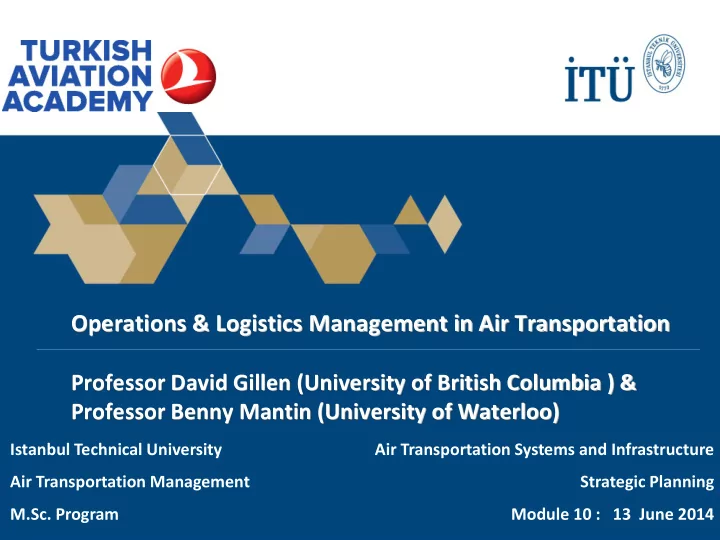

Operations & Logistics Management in Air Transportation Professor David Gillen (University of British Columbia ) & Professor Benny Mantin (University of Waterloo) Istanbul Technical University Air Transportation Systems and Infrastructure Air Transportation Management Strategic Planning M.Sc. Program Module 10 : 13 June 2014
Beergame ITU 2014 Beer Game Debriefing With matterial adopted from Beergame Debriefing, by Kai Riemer, http://www.beergame.org; Lee et al. (1997)
Experiencing the effects of systems dynamics Did you feel yourself controlled by forces in the system from time to time? Or did you feel in control? Did you find yourself "blaming" the decision makers next to you for your problems? Did you feel desperation at any time? 3
Some questions for discussion What, if anything, is unrealistic about this game? Why are there order delays? Why are there production delays? Shipping delays? Why have both distributor and wholesalers? Why not ship beer directly from the factory to the retailer? 4
Results of the game: basic setting (1-4, 9) 5
Bullwhip effect problems High inventory levels Low service level (back orders) High cost High demand fluctuation causes more problems. 6
Bullwhip effect problems Variation in demand along the supply chain requires Shipment capacity Production capacity Inventory capacity to cope with peaks. Most of the time this capacity will be idle. There’s significant cost and investments attached! In the end: high overall cost in the supply chain But competition between supply chains and networks, not just between individual companies! 7
Real world examples Procter and Gamble’s diapers TV set industry (1968) (1997) Machine tool industry (2000) Barilla’s pasta supply chain Semiconductor equipment – PC (1994) industry (2005) Soup manufacturer (1997) 8
Beergame Debriefing, by Kai Riemer, http://www.beergame.org 9
Real world reactions A typical organizational response would be to find the "person responsible" (the guy placing the orders or the inventory manager) and blame him. But the game clearly demonstrates how inappropriate this response is different people following different decision rules for ordering create similar oscillations. We have to change the structural setup! 10
Factors contributing to bullwhip effect Demand forecasting Usage of aggregate and thus inaccurate data does not allow for good predictions High variability leads to continuous adaptations of order policies and thus increases variability upstream Lead time High lead time creates uncertainty Requires high safety stock levels Reduces flexibility and adaptability to unforeseen changes in demand 11
Factors contributing to bullwhip effect Batch ordering Batch ordering at one stage in SC leads to observing high variability at next stage upstream: one week large order followed by weeks with no order Contributors: fixed ordering costs, transportation and price discounts Price fluctuation Stock up when prices are lower large orders Promotions and discounts Inflated orders In time of shortages, suppliers place big orders when expecting to be allocated proportionally 12
Lessons In traditional supply chains information about consumer demand is only passed up the supply chain through the orders that are placed Or using aggregated figure Information is therefore lost High Buffer stocks result Even if each party acts “optimally” individually the result is less than optimal for the whole supply chain Result is higher prices, less sales. BUT: Competition is now supply chain against supply chain and Network against network 13
Results of the game: information sharing (5-8) 14
Barilla Manufacturer of “fresh” and “dry” pasta products Largest pasta manufacturer in the world with >1000 SKUs $2B in sales Very stable demand at retail level DC DC DC North DC Central DC DC Customers Factory South Central DC DC DC DC DC DC
The bullwhip effect at Barilla pasta Upstream variability is much higher Downstream variability at DC: mean (std. dev = 227) demand is about 300, the std. dev. is about 75
Why was this happening in the Barilla SC? Transportation discounts Volume discounts Promotional activity No Min / Max order quantities Variety (SKUs) Lead time and strange inventory management Stock outs (6-7%) cause gaming and over reaction Sales Compensation schemes? Demand information and Forecasting 17
Issues emerging Production: Quality Increases costs Utilization issues Huge inventory costs Central distribution’s Inventory costs Forecast and schedule resources such as trucks work force Hiring went up. Utilization issues Italians hoard and consume even more pasta 18
Periodic Review Inventory Model Inventory (on hand) Order up to level Safety stock L L L Time Place T T T order Time Stock out 19
Proposed solution Just in Time Distribution (JITD ) Another variation is the Vendor Managed Inventory (VMI) Downstream distribution center (DC) reports inventory and sales data electronically to Barilla on a daily basis. Barilla decides how much and when to ship product to the DC. Issues? Internal conflicts Our sales will flatten as we don’t push the products If space is freed at distributor, competitors might come in We run the risk of not being able to adjust shipments External conflicts Distributors many be unwilling. Trust? 20
Run one month Experiment 21
Run one month Experiment 22
Impact on the DC
VMI’s impact on the DC’s service (Time)
Recommend
More recommend